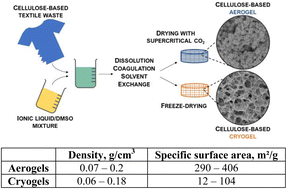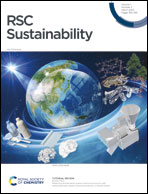Upcycling of textile waste into high added value cellulose porous materials, aerogels and cryogels†
Abstract
Cellulose textile waste was upcycled into highly porous and lightweight cellulose materials. Fabrics made of cotton and regenerated cellulose were dissolved in ionic liquids, 1-ethyl-3-methyl imidazolium acetate ([EMIM][OAc]) or 1,5-diazabicyclo[4.3.0]non-5-enium acetate ([DBNH][OAc]), each mixed with dimethyl sulfoxide (DMSO). Non-solvent induced phase separation triggered by ethanol was used to obtain alcogels, which were dried either with supercritical CO2, or ethanol was exchanged with water and hydrogels were freeze-dried. Alcogels were also atmospheric pressure dried for comparison. Microcrystalline cellulose was used as a reference and processed in the same way. Materials with various porosities and morphologies were obtained. The influence of the cellulose molecular weight, the type of solvent and the drying route on materials' density, porosity, specific surface area and morphology was investigated. The importance of the coagulation pathway, or the way of demixing (instantaneous or delayed), is demonstrated as it allows us to significantly vary the material morphology.

- This article is part of the themed collections: Sustainable fashion and Topic highlight: Sustainable materials


 Please wait while we load your content...
Please wait while we load your content...